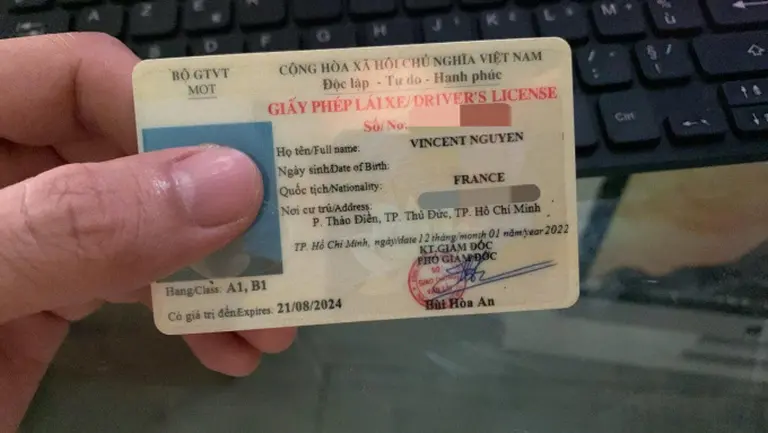Renting and riding motorbikes is a popular choice for foreign tourists in Vietnam. However, it is essential to follow the regulations to ensure safety and compliance with the law.
Anh Tuan Hung, a representative of a motorbike tour company in Ho Chi Minh City, shared that foreign tourists often rent motorbikes to travel within cities or take extended trips across provinces when exploring Vietnam.
Traffic in Vietnam can be quite different, and unfamiliarity with the laws or riding skills could lead to fines or accidents. Anh Hung highlighted six key points for tourists to keep in mind when using this mode of transportation.

French tourist driver’s license converted to corresponding Vietnamese driver’s license
1. Prepare the Necessary Documents
Popular tourist destinations like Hanoi, Da Nang, Ho Chi Minh City, Hoi An, and Nha Trang have plenty of motorbike rental shops. Tourists should look for reputable rental shops by checking reviews on Google Maps or travel advisory sites like TripAdvisor.
To rent a motorbike, you will need:
- A passport (original or a notarized copy).
- A valid International Driving Permit (IDP) or a driving license converted to a Vietnamese license. If you only have a driving license from another country, you may face issues during document checks.
Rental deposits usually range from VND 500,000 to VND 2,000,000. Avoid leaving your original passport at the rental shop; use a notarized copy if requested. Keep your original passport with you or secure it at your hotel.
Ensure that your travel insurance covers accidents involving motorbike riding. Some insurance companies may not provide coverage if you don’t have a valid driving license.
2. Choose the Right Motorbike
- Scooters or manual bikes: Ideal for short trips under 100 km. Scooters are easier to control in crowded areas, while manual bikes are more fuel-efficient and suitable for longer journeys.
- Larger motorcycles: Suitable for long trips and challenging terrains. For motorbikes over 175cc, you’ll need an A2 driving license, and your IDP must explicitly allow riding large motorcycles.
Rental costs:
- Scooters: VND 120,000–200,000/day.
- Manual bikes: VND 80,000–150,000/day.
- Larger motorcycles: From VND 800,000/day.
Before renting, carefully check the rental contract, especially terms related to repair responsibilities for damages or accidents. Inspect the motorbike’s brakes, lights, horn, indicators, and mirrors.
- Fuel levels are often low, so refuel immediately after renting.
- Take photos of the motorbike to document its condition and avoid disputes about pre-existing damage.

French tourists ride motorbikes to enjoy the scenery on Ma Pi Leng Pass.
3. While Riding
Many foreigners describe Vietnam’s traffic as “chaotic,” especially in major cities with dense vehicle movement.
- Be cautious around larger vehicles like buses and trucks, which may not yield the right of way.
- Stick to your lane and avoid driving at night in poorly lit or mountainous areas.
- Buy fuel from official gas stations rather than roadside vendors, as their fuel may be diluted.
If stopped by police for document checks, stay calm and polite. Without a valid driving license, you could face fines.
4. Follow Traffic Laws
- Helmet requirement: Wearing a helmet is mandatory. Opt for high-quality helmets for better safety.
- Drive on the right side of the road. Speed limits are around 40–50 km/h in cities and 60–80 km/h outside urban areas, depending on the area.
- Avoid running red lights or driving in restricted lanes. Pedestrians, bicycles, or other motorbikes may appear suddenly from alleys or intersections—reduce speed and prepare to stop.
- In some areas, larger vehicles like trucks or buses have “priority”; yielding to them is advisable for safety.
- Be aware that hand signals are often used by local drivers instead of indicators.
5. Emergency Situations
- If your motorbike breaks down, call online repair services, find roadside repair shops, or contact your rental provider for assistance.
- In case of an accident, stay calm, take photos of the scene, and call 113 (police) or 115 (emergency services).
- To avoid legal trouble, try to resolve minor issues on the spot amicably, but do not accept blame if the cause is unclear.
6. Practical Tips
- Fuel up early: In rural or mountainous areas, gas stations can be sparse. Always fill up your tank before long trips.
- Avoid restricted areas: In big cities, some lanes or roads are reserved for cars. Riding a motorbike in these areas can result in heavy fines.
- Weather awareness: The rainy season, typically from May to October, can make roads slippery. If you’re not experienced, avoid riding during heavy rain.
- Secure your belongings: Do not leave bags or valuables in the front basket of the motorbike, as theft can occur.
By following these tips, you can enjoy a safer and more enjoyable motorbike adventure in Vietnam.






